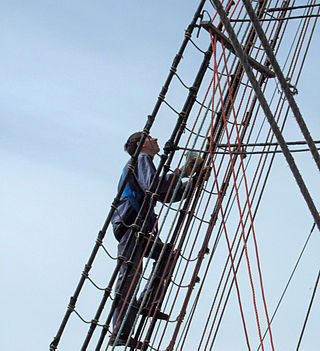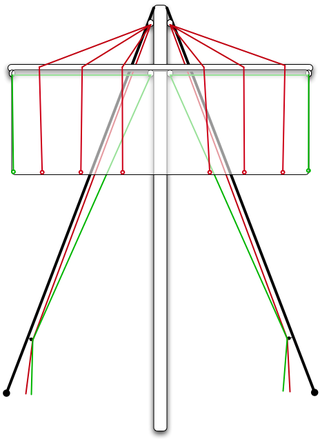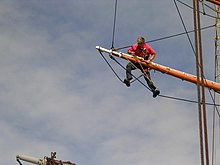
In sailing, a halyard or halliard is a line (rope) that is used to hoist a ladder, sail, flag or yard. The term "halyard" derives from the Middle English halier, with the last syllable altered by association with the English unit of measure "yard". Halyards, like most other parts of the running rigging, were classically made of natural fibre like manila or hemp.

A traveller is a part of the rigging of a boat or ship that provides a moving attachment point for a rope, sail or yard to a fixed part of the vessel. It may take the form of anything from a simple ring on a metal bar or a spar to, especially in a modern yacht, a more complex "car" – a component with bearing-mounted wheels running on a shaped aluminium extrusion.
Sailing ships frequently encounter difficult conditions, whether by storm or combat, and the crew frequently called upon to cope with accidents, ranging from the parting of a single line to the whole destruction of the rigging, and from running aground to fire.

Running rigging is the rigging of a sailing vessel that is used for raising, lowering, shaping and controlling the sails on a sailing vessel—as opposed to the standing rigging, which supports the mast and bowsprit. Running rigging varies between vessels that are rigged fore and aft and those that are square-rigged.

A yard is a spar on a mast from which sails are set. It may be constructed of timber or steel or from more modern materials such as aluminium or carbon fibre. Although some types of fore and aft rigs have yards, the term is usually used to describe the horizontal spars used on square rigged sails. In addition, for some decades after square sails were generally dispensed with, some yards were retained for deploying wireless (radio) aerials and signal flags.
This glossary of nautical terms is an alphabetical listing of terms and expressions connected with ships, shipping, seamanship and navigation on water. Some remain current, while many date from the 17th to 19th centuries. The word nautical derives from the Latin nauticus, from Greek nautikos, from nautēs: "sailor", from naus: "ship".

In sailing, a sheet is a line used to control the movable corner(s) (clews) of a sail.

A Thames sailing barge is a type of commercial sailing boat once common on the River Thames in London. The flat-bottomed barges, with a shallow draught and leeboards, were perfectly adapted to the Thames Estuary, with its shallow waters and narrow tributary rivers. The larger barges were seaworthy vessels, and were the largest sailing vessel to be handled by just two men. The average size was about 120 tons and they carried 4,200 square feet (390 m2) of canvas sail in six working sails. The mainsail was loose-footed and set up with a sprit, and was brailed to the mast when not needed. It is sheeted to a horse, as is the foresail; they require no attention when tacking. The foresail is often held back by the mate to help the vessel come about more swiftly.

Futtock shrouds are rope, wire or chain links in the rigging of a traditional square rigged ship. They run from the outer edges of a top downwards and inwards to a point on the mast or lower shrouds, and carry the load of the shrouds that rise from the edge of the top. This prevents any tendency of the top itself to tilt relative to the mast.

Ratlines are lengths of thin line tied between the shrouds of a sailing ship to form a ladder. Found on all square-rigged ships, whose crews must go aloft to stow the square sails, they also appear on larger fore-and-aft rigged vessels to aid in repairs aloft or conduct a lookout from above.

The term Jacob's ladder, used on a ship, applies to two kinds of rope ladders.

In sailing, gaskets are lengths of rope or fabric used for reefing a sail, or hold a stowed sail in place. In modern use, the term is usually restricted to square-rigged ships, the equivalent items on yachts being referred to by the more prosaic "sail ties".

The spritsail is a four-sided, fore-and-aft sail that is supported at its highest points by the mast and a diagonally running spar known as the sprit. The foot of the sail can be stretched by a boom or held loose-footed just by its sheets. A spritsail has four corners: the throat, peak, clew, and tack. The Spritsail can also be used to describe a rig that uses a spritsail.

A Flemish horse is a footrope on a square rigged sailing ship that is found at the extreme outer end of the yard, or the yardarm. The main footrope runs along the whole length of the yard, but because of its length the angle upwards to where it is attached is quite shallow, and thus it is too high to stand on for some distance inwards. Sailors on this part of the yard stand on the Flemish horse instead, which being shorter hangs down more and hence is low enough to stand on.

The tack of a square-rigged sail is a line attached to its lower corner. This is in contrast to the more common fore-and-aft sail, whose tack is a part of the sail itself, the corner which is secured to the vessel.

Clewlines and buntlines are lines used to handle the sails of a square rigged ship.

A brace on a square-rigged ship is a rope (line) used to rotate a yard around the mast, to allow the ship to sail at different angles to the wind. Braces are always used in pairs, one at each end of a yard (yardarm), termed port brace and starboard brace of a given yard or sail.

The junk rig, also known as the Chinese lugsail, Chinese balanced lug sail, or sampan rig, is a type of sail rig in which rigid members, called battens, span the full width of the sail and extend the sail forward of the mast. While relatively uncommon in use among modern production sailboats, the rig's advantages of easier use and lower maintenance for blue-water cruisers have been explored by individuals such as trans-Atlantic racer Herbert "Blondie" Hasler and author Annie Hill.

Literally, the word pinisi refers to a type of rigging of Indonesian sailing vessels. A pinisi carries seven to eight sails on two masts, arranged like a gaff-ketch with what is called 'standing gaffs' — i.e., unlike most Western ships using such a rig, the two main sails are not opened by raising the spars they are attached to, but the sails are 'pulled out' like curtains along the gaffs which are fixed at around the centre of the masts.
This glossary of nautical terms is an alphabetical listing of terms and expressions connected with ships, shipping, seamanship and navigation on water. Some remain current, while many date from the 17th to 19th centuries. The word nautical derives from the Latin nauticus, from Greek nautikos, from nautēs: "sailor", from naus: "ship".


















